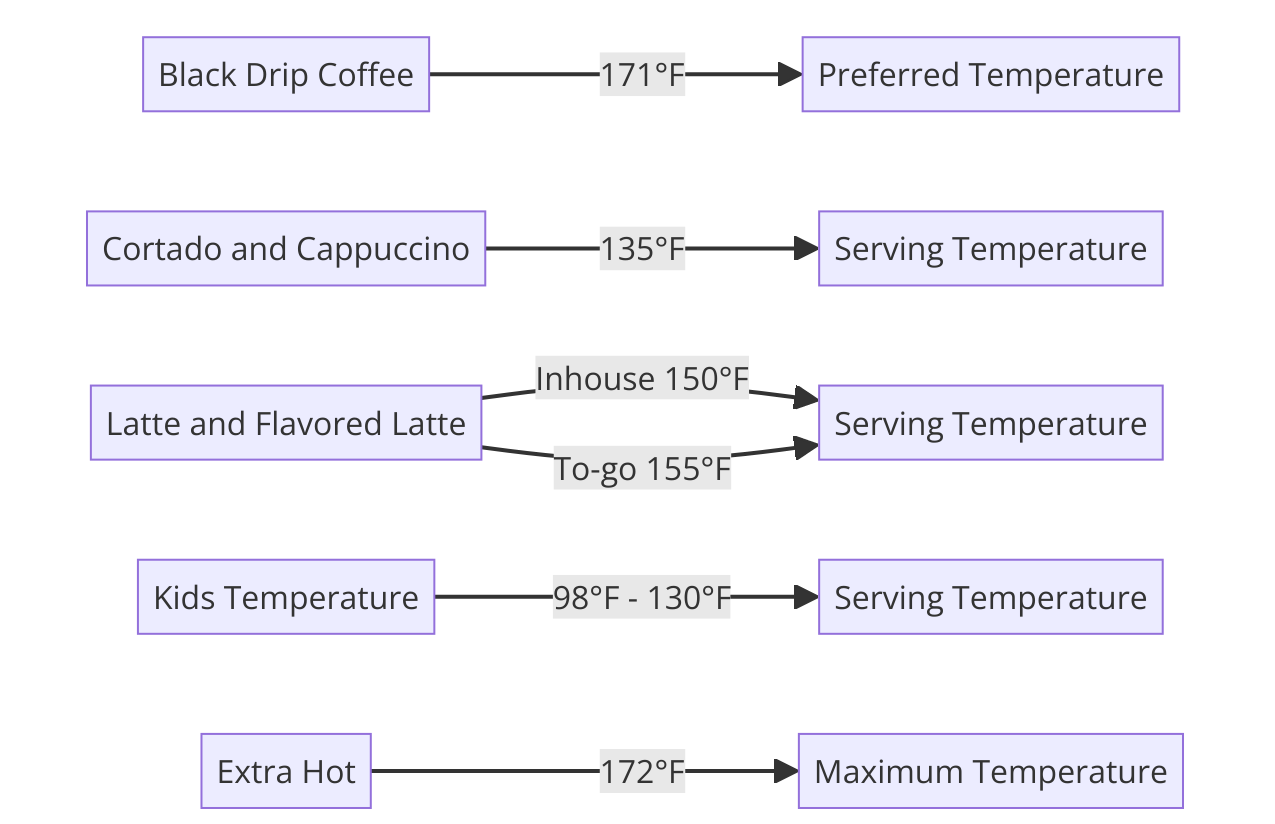Optimal Temperatures for Brewing and Serving Coffee: A Guide for Baristas and Coffee Enthusiasts
Coffee brewing is both an art and a science, demanding precision and care to extract the best flavors from the beans. The Specialty Coffee Association (SCA) has set rigorous standards for brewing temperatures, tailored to different coffee-making methods. This article explores these guidelines and discusses why adherence is vital for crafting the perfect cup of coffee.
Coffee Serving Temperatures
While brewing temperatures are higher, the serving temperature of the coffee is generally lower to enhance the drinking experience. Coffee in its various forms is typically served at temperatures ranging from 150°F to 170°F (68°C to 79.4°C) for espresso drinks. At this range, the coffee's intricate flavors and aromas are more perceptible and enjoyable, without the discomfort of excessive heat.
A large study by the Specialty Coffee Association a handful of years ago discovered that 171 degrees Fahrenheit is the preferred temperature to consume black drip coffee.
With espresso and milk the more air you induce into the milk the quicker the drink is intended to be consumed, as this air will flatten quickly and change the texture of the drink. So when crafting a drink it’s important to consider the length of consumption as a guild to the serving temperature.
Another amazing factor of coffee is how it changes in taste as it goes through different temperature phases. Seriously! Try your coffee at 200 degrees and every 10 degrees it cools, try it again. You will be amazed at how much your taste profile and mouth feel are affected at various temperatures. Notice how the flavor profiles change and how more chocolatey notes emerge and some acidity decreases as is it cools,
With this in mind, At Conscious Bean®, we have targeted specific serving temperatures for specific coffee drinks.
Cortado and Cappuccino
These drinks are meant to be consumed in just a few minutes. The temperature should be approachable enough for immediate consumption. If the guest gets the drink and sets it down to “let it cool” by the time they drink it the air will have flattened and the drink will not have the texture desired. For consistency, we prefer a wet foam to a dry airy foam but the same recipe premise will apply.
Recipe: Turn off the steam wand when the milk is 130 degrees Fahrenheit which will leave your resulting milk temperature at 135-degree
(milk paired with the espresso that’s around 200 degrees will bring the total drink temp up in the 2/1 ratio of textured milk to espresso.)
Latte and Flavored Latte
Latte’s and flavored lattes have very little milk texturing. They are primarily milk (not air), so they are intended to be consumed slower over a longer period as there is less air to settle and affect drink texture.
Recipe: Inhouse 150 degrees. To go 155 degrees
Kids Temperature
This varies a bit by age and sensitivity, but around 98 degrees for the young ones (bottle temp) or up to 130 degrees for older kids. If an adult asks for a “kid-friendly temp” for themselves so they can drink it and not wait. The average adult is looking for a temperature of 135, in our experience.
Extra Hot
Some people just want a really hot drink. Maybe because they have really cold hands and want to keep warm. Maybe it’s a test to see if you will break logic and curdle their milk. Maybe it’s because they think of black coffee and “know it’s supposed to be really hot” with no real awareness that espresso and milk is a very different thing. Maybe they just want to drink it when they arrive somewhere, regardless of the motivation, here’s the low down. 180 degrees is where milk curdles, sometimes lower temperatures for high-quality non-homogonized diaries. Same for many non-dairy alternatives who prefer lower temperatures even in the 160s before curdling. So that is the absolute maximum we will go. Remember the temperature will continue to rise on the thermometer even after you turn off the steam wand, so our recipe is
Recipe: 172 degrees on the thermometer - turn it off and the temp will rise. When extra heating the milk keep your steam wand away distance from the steaming pitcher so you don’t superheat the steaming pitcher and scald the milk.
For non-dairy offerings, 165 degrees is the highest we will offer.
In the remainder of this article, we will discuss details of the various methods and Coffee Brewing Temperatures.
Coffee Brewing Temperatures
Espresso
Espresso brewing magnifies the nuances of coffee varieties and roast profiles, significantly affecting the flavor, body, and overall profile of the espresso shot. The choice of coffee variety and roast can influence not just the flavor but also the extraction dynamics during the espresso-making process.
Light Roasts - While less common for espresso, light roasts can be used to achieve a more pronounced acidity and retain unique origin characteristics. However, they require precise control during extraction to avoid sourness, as they can be more challenging to extract fully under high pressure.
Medium Roasts - These are generally preferred for espresso as they offer a good balance between acidity and bold flavor, allowing for a consistent extraction that highlights both the bean’s natural flavors and the caramelization notes from roasting.
Dark Roasts - Traditionally favored for espresso, dark roasts provide a strong, bold flavor that stands up well to the intensity of espresso extraction. The darker roasting process reduces acidity and increases bitterness, which can complement the natural sweetness added by milk in drinks like lattes and cappuccinos.
Roast Profiles' Impact on Extraction
The choice of roast and bean variety will affect the flavor intensity, body, and crema of the espresso. Darker roasts tend to produce a thicker crema and a bolder, less acidic espresso, whereas lighter roasts may produce a more complex and nuanced shot, albeit with a thinner crema.
Different roasts require adjustments in grind size and tamping pressure to optimize extraction. Lighter roasts may need a finer grind to increase extraction, while darker roasts might need a coarser grind to prevent over-extraction.
Espresso Brewing Temperatures
Espresso requires precise temperature control during its extraction, the extraction can vary by many aspects, including variety, process, roast profile, time duration since roast date, brew method, environmental temperature, humidity, sun exposure, grinder burr size, quality, and built up heat…there’s more. It’s incredible. So as you can see more than we will go into in this article but according to the SCA, the optimal water temperature for espresso is between 195°F and 205°F (90.6°C to 96.1°C). This range is crucial as it influences the chemical reactions that occur during coffee extraction, affecting the flavor, body, and aroma of the espresso.
Temperature consistency ensures that the espresso is neither under-extracted—leading to a weak, sour cup—nor over-extracted—resulting in a bitter, harsh drink. Modern espresso machines often come equipped with technology to maintain water temperature within this narrow band, aiding baristas in achieving consistent quality.
Lower Temperatures (190°F - 200°F) tend to extract more fruity acids but can lead to under-extraction of oils and bitter compounds, resulting in a sour taste if not carefully monitored.
Higher Temperatures (200°F - 205°F) increase the extraction rate of oils and bitter compounds which can balance or overpower the acidity in darker roasts, suitable for bold, strong coffee.
Drip Coffee
Brewing Temperatures For Drip Coffee
The recommended brewing temperature is about 200°F (93°C). This temperature maximizes the extraction of desirable flavors while minimizing the release of bitter compounds and tannins. The SCA's Golden Cup Standard highlights that maintaining the correct brewing temperature is essential for this balance, ensuring that each cup of coffee meets the highest standards of taste and aroma.
The brewing process at these temperatures allows for optimal interaction between hot water and coffee grounds, facilitating the proper extraction of soluble compounds that contribute to the coffee's overall sensory profile.
There are still many opinions about this temperature and other considerations like equalization of the vessel temperature for even extraction. We have even seen studies that showed how using water over 212 degrees still fell within the range of optimal brewing what's it thermo equalized with the “hot” brewing vessel. So the only consistency to be found here is based on the variety and roast you choose and the way it tastes after you brew it.
COLD BREW
The steeping temperature and duration for cold brew coffee significantly influence the extraction and final flavor of the beverage. Lower temperatures require longer brewing times. Generally, when brewing cold brew at room temperature (around 20-22°C), the recommended steeping time ranges from 12 to 24 hours. In contrast, if steeping in a refrigerator at about 5°C, the time extends up to 16-24 hours or more to achieve optimal extraction.
The extraction process is faster at room temperature due to the higher temperature facilitating more efficient extraction of flavors and caffeine from the coffee grounds. However, brewing in the refrigerator, although slower, can lead to a smoother and sometimes sweeter flavor profile, as the colder conditions moderate the extraction rate and prevent over-extraction that can lead to bitterness.
A detailed understanding of the correlation between temperature, time, and extraction can help in fine-tuning the brewing process to suit personal taste preferences. The general rule observed is that the colder the brewing temperature, the longer the coffee should steep to achieve a well-extracted brew without risking a watery or under-extracted outcome.
For those looking for a more systematic approach, using trial and error while adjusting the steeping duration based on the room or refrigerator temperatures would be the practical way to find the perfect balance for your preferred cold brew flavor.
Roast Profiles for Cold Brew
Light Roasts - These preserve more of the original flavors of the coffee bean, which can include floral, fruit, and earthy notes. Light roasts can result in a more acidic brew, which might need a longer steep time to fully develop the flavors when used for cold brewing.
Medium Roasts - Offering a balance between flavor and acidity, medium roasts are often recommended for cold brew. They provide a good balance of sweetness and complexity, which can be extracted effectively even at lower temperatures.
Dark Roasts - With their bold, robust flavors and reduced acidity, dark roasts can produce a chocolatey and sometimes smoky cold brew. The intense flavors from dark roasts are easier to extract, often requiring shorter steep times to avoid over-extraction, which can lead to overly bitter flavors.
Steeping Impact on Cold-Brewed Coffee
Lighter roasts may require finer grinds or longer steep times (our preferred) to extract their full range of flavors due to their denser structure. In contrast, darker roasts, being more porous, may extract too quickly, risking bitterness if steeped too long. The attributes of the bean and roast will affect your extraction time.
Darker roasts tend to impart a fuller body and smoother mouthfeel to the cold brew, as they extract more oils and soluble solids at lower temperatures compared to lighter roasts.
Experimenting with different bean varieties and roast profiles while adjusting the steeping parameters (like time and temperature) can significantly influence the sensory characteristics of the final cold brew. These elements allow for a wide range of customization, catering to personal preferences or specific customer profiles in a commercial setting.
As you can see, be it espresso, batch-brewed drip coffee, cold brew, or any other various brew method this article underscores the crucial role of precise temperature awareness to find the art and science of coffee brewing. From the intricacies of espresso to the nuances of cold brew, understanding and applying the correct temperatures is essential for extracting the full spectrum of flavors that well-prepared high-quality coffee has to offer.

